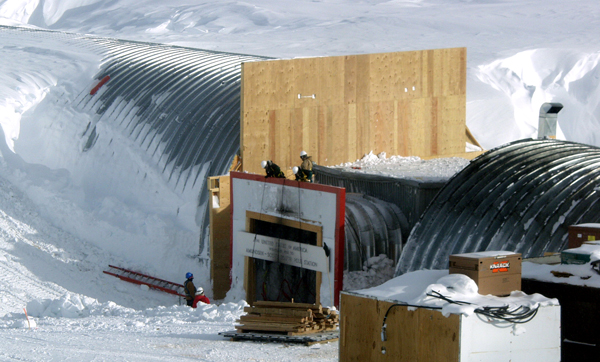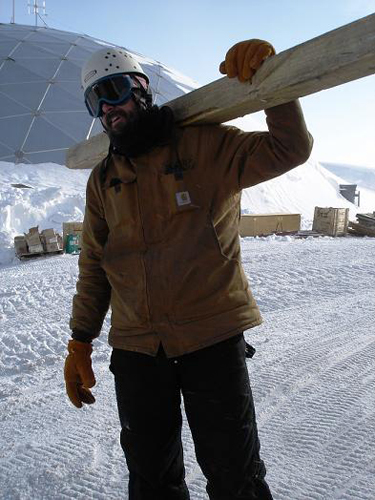
Photo Credit: Ethan Dicks |
Mark Freeland and the heavy carpenter crew remove the Amundsen-Scott South Pole Station sign welcoming people to the iconic dome building, which will be removed in the coming years. |
Sign of the times
Carpenter Mark Freeland finds himself at the South Pole during an historic moment
By Tracy D'Souza, South Pole correspondent
Posted January 3, 2007
“Men, you just made history.”
With those words, Mark Freeland, foreman of the heavy carpenter crew and overseer of the cargo arches project, breathed a sigh of relief. The iconic sign that welcomed one and all to the Amundsen-Scott South Pole Station Dome was safely down from its 30-year perch over the entrance. His high-profile project for the construction of storage arches for cargo could now begin in earnest.
Getting to the worksite at the bottom of the world went a little less smoothly. A member of the self-proclaimed “Boomerang Gang,” Freeland’s odyssey to the Pole began with an eight-day layover at McMurdo Station.
The “Boomerang Gang” consisted of five South Pole-bound men who roomed, bonded, and repeatedly packed and unpacked their luggage in their dorm room in Building 155, the station’s central hub of activity.
Despite the recurring cancellations, the men found time at McMurdo to swap stories about their diverse backgrounds as electricians, scientists and Navy sailors, as well as to acquaint themselves with inner workings of McMurdo and its scenic environment.
“I never laughed so much in my entire life. I think it’s because of this motley crew of people,” Freeland said.

Photo Credit: Tracy D'Souza
Carpenter Mark Freeland at the South Pole.
Like the rest of the “Boomerang Gang,” this was Freeland’s first season with U.S. Antarctic Program. Originally from Denver and currently residing in Colorado Springs, Colo., with his wife and four kids, Freeland had met fellow colleagues in construction who had worked in Antarctica, but had never seriously considered it for himself.
He has worked in Colorado as a surveyor, concrete foreman, foreman and assistant superintendent for projects large and small in the Denver area. His experience in both residential and commercial construction led him to know every phase of construction.
“I have always taken the leadership position because of my ability to read blueprints, communicate and delegate,” Freeland said.
Wanting to explore opportunities overseas, Freeland applied for positions in Iraq and, just to see what would happen, Antarctica. He got a phone call that surprised him, and shocked his wife and four children when he broke the news about the offer to become heavy carpenter foreman at the South Pole Station.
“My wife was very supportive, and called it a once in a lifetime opportunity. My kids were initially kind of scared for me, then excited. They get to brag about dad at school. I wanted to show all four kids that you only get one chance. Life gives you very few opportunities.”
Freeland had seized an incredible opportunity: the erection of the Logistics building, which will create much need storage for the new elevated station while encircling the Dome, closing off the entrance to the iconic station. As foreman, Freeland oversees the raising and stitching together of the metal arches to enclose the whole structure for use this winter.
The construction of the Logistics building is inevitably tied with the demise of the Dome, as its entrance has become obscured behind the new building. Freeland is very aware of the effects of the Dome on the station’s seasoned inhabitants, especially in dropping the sign and removing the entrance. He gave ample warning before his crew took the sign down, so people could take their last, historic pictures.
On the other hand, he and his new crew, almost all here for their first season, had only been at the Pole a few days before they undertook the weighty task of lowering the sign.
“As a new person, I have no emotional attachment,” he said. “However, I took a lot of precautions on the sign because I recognized the historical value. When [we] dropped it, I wanted the dramatic effect of a curtain coming down.”
Freeland was impressed by the heavy weight of the sign, and the incredible feat of carpentry to install and secure all the letters. Driving the sign through the station, he jokingly placed the sign in front of the Skua Shack, a small building that serves as a repository for recycled items, offering it to wide-eyed Twin Otter pilots as a memento.
Not to worry: The sign is safely in storage awaiting a fresh paint job and the decision on where to place it in the new station building.
With that momentous task completed, Freeland continues to make progress on the construction, and loves working with his crew. He currently is ahead of schedule for construction, but continues to plan and anticipate for anything unexpected.
“He is definitely one of the coolest bosses I’ve ever had,” says Dustin Woolsey, a carpenter on Freeland’s crew. Bob Zeien, a carpenter from McMurdo, added that Colorado craftsman both looks at the big picture and looks out for his crew.
With his charismatic voice and instant camaraderie with everyone on station, Freeland has also become a noted personality. He sings in the band Beer Plugs, which will debut at the South Pole New Year’s Eve party. Having once attended broadcasting school, Freeland would like to combine his love of music and radio personality into a show about rock ’n’ roll. He is currently exploring the idea of recording voiceovers and possibly podcasts upon his return to the States.
However, for right now, Freeland is very happy to be at the Pole. “I am here during a monumental year, with the International Polar Year and the dedication [of the new station]. This is like the Y2K of the South Pole, and I can say ‘I was there.’”






